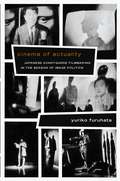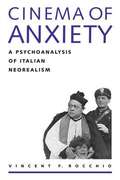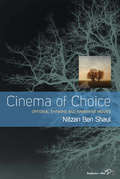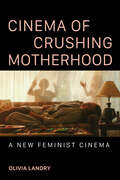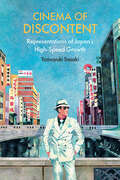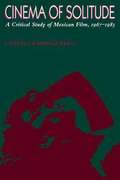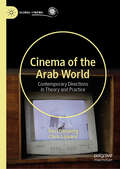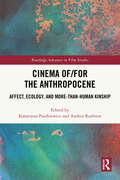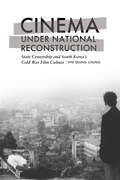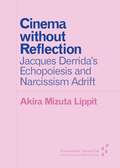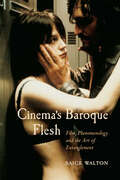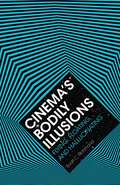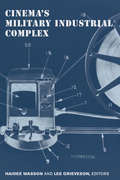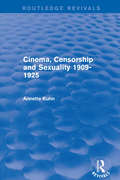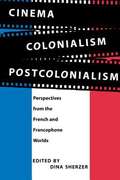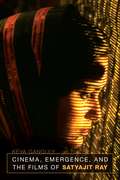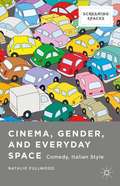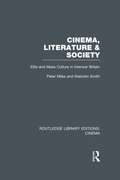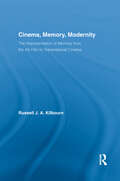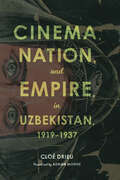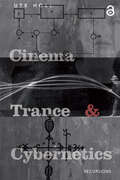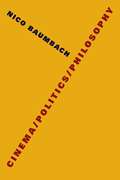- Table View
- List View
Cinema of Actuality: Japanese Avant-Garde Filmmaking in the Season of Image Politics
by Yuriko FuruhataDuring the 1960s and early 1970s, Japanese avant-garde filmmakers intensely explored the shifting role of the image in political activism and media events. Known as the "season of politics," the era was filled with widely covered dramatic events from hijackings and hostage crises to student protests. This season of politics was, Yuriko Furuhata argues, the season of image politics. Well-known directors, including Oshima Nagisa, Matsumoto Toshio, Wakamatsu Kōji, and Adachi Masao, appropriated the sensationalized media coverage of current events, turning news stories into material for timely critique and intermedial experimentation. Cinema of Actuality analyzes Japanese avant-garde filmmakers' struggle to radicalize cinema in light of the intensifying politics of spectacle and a rapidly changing media environment, one that was increasingly dominated by television. Furuhata demonstrates how avant-garde filmmaking intersected with media history, and how sophisticated debates about film theory emerged out of dialogues with photography, television, and other visual arts.
Cinema of Anxiety: A Psychoanalysis of Italian Neorealism
by Rocchio Vincent F.Rocchio builds his analysis around case studies of the films Rome: Open City, Bicycle Thieves, La Terra Trema, Bitter Rice, and Senso. Through the lens of psychoanalysis, he challenges the traditional understanding of Neorealism as a progressive cinema and instead reveals the anxieties it encodes: a society in political turmoil, an economic system in collapse, and a national cinema in ruins; while war, occupation, collaboration, and retaliation remain a part of everyday life.
Cinema of Choice
by Nitzan Ben ShaulStandard Hollywood narrative movies prescribe linear narratives that cue the viewer to expect predictable outcomes and adopt a closed state of mind. There are, however, a small number of movies that, through the presentation of alternate narrative paths, open the mind to thoughts of choice and possibility. Through the study of several key movies for which this concept is central, such as Sliding Doors, Run Lola Run, Inglourious Basterds, and Rashomon, Nitzan Ben Shaul examines the causes and implications of optional thinking and how these movies allow for more open and creative possibilities. This book examines the methods by which standard narrative movies close down thinking processes and deliver easy pleasures to the viewer whilst demonstrating that this is not the only possibility and that optional thinking can be both stimulating and rewarding.
Cinema of Collaboration: DEFA Coproductions and International Exchange in Cold War Europe (Film Europa #21)
by Mariana IvanovaFrom their very inception, European cinemas undertook collaborative ventures in an attempt to cultivate a transnational “Film-Europe.” In the postwar era, it was DEFA, the state cinema of East Germany, that emerged as a key site for cooperative practices. Despite the significant challenges that the Cold War created for collaboration, DEFA sought international prestige through various initiatives. These ranged from film exchange in occupied Germany to partnerships with Western producers, and from coproductions with Eastern European studios to strategies for film co-authorship. Uniquely positioned between East and West, DEFA proved a crucial mediator among European cinemas during a period of profound political division.
Cinema of Crushing Motherhood: A New Feminist Cinema
by Olivia LandryTwenty-first century contemporary films like Emily Atef’s Das Fremde in mir and Savannah Leaf’s Earth Mama portray motherhood as a source of regret, exhaustion, rage, shame, guilt, and disgust. Olivia Landry analyzes this new feminist cinema and the ways it embraces and explores the crushing burden of mothering children. Landry surveys films released in North America, Europe, and Australia over a period beginning in 2007. As she shows, revelation and the expression of negative feelings upend the traditional image of the perfect, self-sacrificial, and happy mother. Landry tracks how radical positions like maternal regret and family abolition have replaced age-old tropes while also going beyond portrayals of maternal ambivalence. Her feminist method casts off psychoanalysis and renounces pathological approaches to motherhood to show how a generation of filmmakers have insisted on the subjective position and experience of the mother rather than that of the child. Bold and groundbreaking, Cinema of Crushing Motherhood looks at taboo-breaking films and illuminates the emotions and affects that make them so powerful.
Cinema of Discontent: Representations of Japan's High-Speed Growth (SUNY series, Horizons of Cinema)
by Tomoyuki SasakiFrom the mid-1950s to the mid-1970s, Japan experienced an unprecedented level of economic growth, transforming itself from a war-devastated country to a global economic power. Our image of postwar Japan has been shaped by this event, and we tend to see its history as a story of great national success. Cinema of Discontent challenges this view and details the tensions generated by massive and intense capitalist development through analyses of popular cinema produced during the era of high-speed growth. The films discussed in this book, directed by Kawashima Yūzō, Masumura Yasuzō, Inoue Akira, Ezaki Mio, and Kumashiro Tatsumi, attracted broad audiences yet remain understudied. Cinema of Discontent contextualizes these films in relation to the politics, economy, intellectual discourse, and cultural texts of the time. By doing so, it demonstrates how these films address problems immanent to Japan's postwar capitalism, including uneven development, increasing corporate control over individuals, precarious and contingent work, and militarized peace and prosperity.
Cinema of Exploration: Essays on an Adventurous Film Practice (AFI Film Readers)
by James Leo Cah Luca CaminatiDrawing together 18 contributions from leading international scholars, this book conceptualizes the history and theory of cinema’s century-long relationship to modes of exploration in its many forms, from colonialist expeditions to decolonial radical cinemas to the perceptual voyage of the senses made possible by the cinematic apparatus. This is the first anthology dedicated to analysing cinema’s relationship to exploration from a global, decolonial, and ecological perspective. Featuring leading scholars working with pathbreaking interdisciplinary methodologies (drawing on insights from science and technology studies, postcolonial theory, indigenous ways of knowing, and film theory and history), it theorizes not only cinema’s implication in imperial conquest but also its cutting-edge role in empirical expansion and experiments in sensual and critical perception. The collected essays consider filmmaking in cross-cultural contexts and films made in or about peoples in South America, Asia, Africa, Indigenous North America, as well as polar, outer space, and underwater exploration, with famous figures such as Jacques Yves Cousteau alongside amateur and scientific filmmakers. The essays in this collection are ideal for a broad range of scholars, graduate students, and advanced undergraduate students in cinema and media studies, cultural studies, and cognate fields.
Cinema of Solitude: A Critical Study of Mexican Film, 1967-1983
by Berg Charles RamírezIn thematically arranged chapters, Berg investigates the images of women, men, and social structures portrayed in New Cinema films. He finds that women characters have begun to reject traditional stereotypes for more positive images, while male characters have grown ambiguous and undefined as machismo is abandoned. Other chapters trace the continuing marginalization of Indians in Mexican culture, the changes in male dominance within the family, and the disruptive social and economic effects caused by migration.
Cinema of the Arab World: Contemporary Directions in Theory and Practice (Global Cinema)
by Terri Ginsberg Chris LippardThis volume engages new films and modes of scholarly research in Arab cinema, and older, often neglected films and critical topics, while theorizing their structural relationship to contemporary developments in the Arab world. The volume considers the relationship of Arab cinema to transnational film production, distribution, and exhibition, in turn recontextualizing the works of acknowledged as well as new directorial figures, and country-specific phenomena. New documentary and experimental practices are referenced and critiqued, while commercial cinema is covered both as an industrial product and as one of several instances of contestation. The volume thus showcases the breadth and depth of Arab film culture and its multilayered connections to local conditions, regional affiliations, and the tendencies and aesthetics of global cinema.
Cinema of/for the Anthropocene: Affect, Ecology, and More-Than-Human Kinship (Routledge Advances in Film Studies)
by Andrea Ruthven Katarzyna PaszkiewiczCinema of/for the Anthropocene sheds new light on the question of how films can allow us to resituate ourselves within what is known today as the Anthropocene. The authors address this question through a variety of disciplines and theoretical perspectives, from film and cultural studies, new materialisms, critical posthumanism and animal studies, critical race theory and Indigenous media studies, to gender and sexuality studies, with a primary focus on films produced in the United States and Canada.The volume moves beyond the mere acknowledgment of the devastating damage inflicted during the Anthropocene to think about new ways of inhabiting the world through concepts such as affect, response-ability, and more-than-human kinship. The writers in this collection respond to its invitation by addressing a range of genres and modes, thus complicating the apocalyptic discourses which have typically been central to the studies on the Anthropocene: in addition to dystopian films, the volume discusses animated films, Hollywood biopics, climate change documentaries, experimental film, comedy, horror sci-fi, as well as disease thriller and survival film. Taken together, the chapters offer cross-disciplinary readings of the cinema of/for the Anthropocene, showing ways in which it can help us re-orient our thinking to make sense of the current age and address the planetary-scale environmental catastrophe.This volume will appeal to researchers and students in film studies, cultural studies, and the burgeoning field of environmental humanities.
Cinema under National Reconstruction: State Censorship and South Korea’s Cold War Film Culture
by Hye Seung ChungCinema under National Reconstruction calls for a revisionist understanding of state film censorship during successive Cold War military regimes in South Korea (1961–1988). Drawing upon primary documents from the Korean Film Archive’s digitized database and framing South Korean film censorship from a transnational perspective, Hye Seung Chung makes the case that, while political oppression/repression existed inside and outside the film industry during this period, film censorship was not simply a tool for authoritarian dictatorship. Through such case studies as Yu Hyun-mok’s The Stray Bullet (1961), Ha Kil-jong’s The March of the Fools (1975), and Yi Chang-ho’s Declaration of Fools (1983), the author defines censorship as a dialogical process of cultural negotiations wherein the state, the film industry, and the public fight out a battle over the definitions and functions of national cinema. In the context of Cold War Korea, one cannot fully understand or construct film history without reassessing censorship as a productive feedback system where both state regulators and filmmakers played active roles in shaping the new narrative or sentiment of the nation on the big screen.
Cinema without Reflection: Jacques Derrida’s Echopoiesis and Narcissim Adrift (Forerunners: Ideas First)
by Akira Mizuta LippitCinema without Reflection traces an implicit film theory in Jacques Derrida&’s oeuvre, especially in his frequent invocation of the myth of Echo and Narcissus. Derrida&’s reflections on the economies of image and sound that reverberate in this story, along with the spectral dialectics of love, mirrors, and poiesis, serve as the basis for a theory of cinema that Derrida perhaps secretly imagined. Following Derrida&’s interventions on Echo and Narcissus across his thought on the visual arts, Akira Mizuta Lippit seeks to return to a theory of cinema adrift in Derrida&’s philosophy. Forerunners is a thought-in-process series of breakthrough digital works. Written between fresh ideas and finished books, Forerunners draws on scholarly work initiated in notable blogs, social media, conference plenaries, journal articles, and the synergy of academic exchange. This is gray literature publishing: where intense thinking, change, and speculation take place in scholarship.
Cinema's Baroque Flesh: Film, Phenomenology and the Art of Entanglement
by Saige WaltonIn Cinema's Baroque Flesh, Saige Walton draws on the philosophy of Maurice Merleau-Ponty to argue for a distinct aesthetic category of film and a unique cinema of the senses: baroque cinema. Combining media archaeological work with art history, phenomenology, and film studies, the book offers close analyses of a range of historic baroque artworks and films, including Caché, Strange Days, the films of Buster Keaton, and many more. Walton pursues previously unexplored connections between film, the baroque, and the body, opening up new avenues of embodied film theory that can make room for structure, signification, and thought, as well as the aesthetics of sensation.|In Cinema's Baroque Flesh, Saige Walton draws on the philosophy of Maurice Merleau-Ponty to argue for a distinct aesthetic category of film and a unique cinema of the senses: baroque cinema's.
Cinema's Bodily Illusions: Flying, Floating, and Hallucinating
by Scott C. RichmondDo contemporary big-budget blockbuster films like Gravity move something in us that is fundamentally the same as what avant-garde and experimental films have done for more than a century? In a powerful challenge to mainstream film theory, Cinema&’s Bodily Illusions demonstrates that this is the case. Scott C. Richmond bridges genres and periods by focusing, most palpably, on cinema&’s power to evoke illusions: feeling like you&’re flying through space, experiencing 3D without glasses, or even hallucinating. He argues that cinema is, first and foremost, a technology to modulate perception. He presents a theory of cinema as a proprioceptive technology: cinema becomes art by modulating viewers&’ embodied sense of space. It works primarily not at the level of the intellect but at the level of the body. Richmond develops his theory through examples of direct perceptual illusion in cinema: hallucinatory flicker phenomena in Tony Conrad&’s The Flicker, eerie depth effects in Marcel Duchamp&’s Anémic Cinéma, the illusion of bodily movement through onscreen space in Stanley Kubrick&’s 2001, Godfrey Reggio&’s Koyaanisqatsi, and Alfonso Cuarón&’s Gravity. In doing so he combines insights from Maurice Merleau-Ponty&’s phenomenology of perception and James J. Gibson&’s ecological approach to perception. The result is his distinctive ecological phenomenology, which allows us to refocus on the cinema&’s perceptual, rather than representational, power.Arguing against modernist habits of mind in film theory and aesthetics, and the attendant proclamations of cinema&’s death or irrelevance, Richmond demonstrates that cinema&’s proprioceptive aesthetics make it an urgent site of contemporary inquiry.
Cinema's Military Industrial Complex
by Haidee Wasson Lee GrievesonThe vast and influential American military has been aided and abetted by cinema since the earliest days of the medium. The army, navy, and air force put films to work in myriad ways, enlisting them to entertain, train, and heal soldiers as well as to propagandize, strategize, spy, map, and develop weapons, from rifles to atomic bombs. Presenting new essays based on archival research, Cinema’s Military Industrial Complex addresses the relationship of military cinema to Hollywood, technological innovation, new modes of filmmaking, unique film styles and genres, and the rise of American soft power across the long twentieth century. This rich and timely volume is essential for scholars interested in the military’s use of media and the exercise of influence within and beyond American borders.
Cinema, Censorship and Sexuality 1909-1925 (Cinema And Society Ser.)
by Annette KuhnFirst published in 1988. This book shows how censorship as a set of institutions, practices and discourses was involved in the struggle over the nature of cinema in the early twentieth century. It also reveals the part played in this struggle by other institutions, practices and discourses — for example ‘new’ knowledge about sexuality and organisations devoted to the promotion of public morality. Instead of censorship simply being an act of prohibition by a special institution, this work reveals the issues at work were far more complex and contradictory — opening up critical scrutiny and challenging assumptions. This title will be of interest to students of media and film studies.
Cinema, Colonialism, Postcolonialism: Perspectives from the French and Francophone Worlds
by Dina SherzerThrough an examination of France and its colonies, multiethnic contemporary France, and cinematic discourses which have been and are being produced about France's colonial past, these authors explore how the images relay underlying assumptions and their relation to historical and political facts. A variety of subjects and viewpoints inform these studies, which cover the entire range of films on that topic.
Cinema, Emergence, and the Films of Satyajit Ray
by Keya GangulyThe book shows how Satyajit Ray, a renowned Indian filmmaker, redefines the grammar of cinema to make possible a vision of society unavailable in the novel or theater and documents the capacity of the image to conceptualize a different world.
Cinema, Gender, And Everyday Space
by Natalie FullwoodCommedia all'italiana, or Comedy, Italian style, became popular at a time of great social change. This book, utilizing comedies produced in Italy from 1958-70, examines the genre's representation of gender in the everyday spaces of beaches and nightclubs, offices, cars, and kitchens, through the exploration of key spatial motifs.
Cinema, Literature & Society: Elite and Mass Culture in Interwar Britain (Routledge Library Editions: Cinema)
by Malcolm Smith Peter MilesDuring the interwar period cinema and literature seemed to be at odds with each other, part of the continuing struggle between mass and elite culture which so worried writers such as Aldous Huxley, T.S. Eliot and the Leavises. And this cultural divide appeared to be sharp evidence of a deeper struggle for control of the nation’s consciousness, not only between dominant and oppositional elements within Britain, but between British and American vales as well. On the one hand, films like Sing As We Go, Proud Valley, and The Stars Look Down consolidated the assumptions about the existence of a national rather than separate class identities. On the other hand, working-class literature such as Love on the Dole articulated working-class experience in a manner intended to bridge the gap between the ‘Two Englands’. This book, originally published in 1987, examines how two of the most significant cultural forms in Britain contributed indirectly to the stability of Britain in the interwar crisis, helping to construct a new class alliance. A major element in the investigation is an analysis of the mechanics of the development of a national cultural identity, alongside separate working-class culture, the development of the lower-middle class and the implications of the intrusion of Hollywood culture. The treatment throughout is thematic rather than text-oriented – works of Graham Greene, George Orwell, Bert Coombes, Evelyn Waugh, the British Documentary Film Movement and Michael Balcon are included in the wide range of material covered.
Cinema, Memory, Modernity: The Representation of Memory from the Art Film to Transnational Cinema (Routledge Advances in Film Studies #6)
by Russell J.A. KilbournSince its inception, cinema has evolved into not merely a ‘reflection’ but an indispensable index of human experience – especially our experience of time’s passage, of the present moment, and, most importantly perhaps, of the past, in both collective and individual terms. In this volume, Kilbourn provides a comparative theorization of the representation of memory in both mainstream Hollywood and international art cinema within an increasingly transnational context of production and reception. Focusing on European, North and South American, and Asian films, Kilbourn reads cinema as providing the viewer with not only the content and form of memory, but also with its own directions for use: the required codes and conventions for understanding and implementing this crucial prosthetic technology — an art of memory for the twentieth-century and beyond.
Cinema, Nation, and Empire in Uzbekistan, 1919-1937
by Cloé DrieuBetween the founding of Soviet Uzbekistan in 1924 and the Stalinist Terror of the late 1930s, a nationalist cinema emerged in Uzbekistan giving rise to the first wave of national film production and an Uzbek cinematographic elite. In Cinema, Nation, and Empire in Uzbekistan Cloé Drieu uses Uzbek films as a lens to explore the creation of the Soviet State in Central Asia, starting from the collapse of the Russian Empire up through the eve of WWII. Drieu argues that cinema provides a perfect angle for viewing the complex history of domination, nationalism, and empire (here used to denote the centralization of power) within the Soviet sphere. By exploring all of film’s dimensions as a socio-political phenomenon—including film production, film reception, and filmic discourse—Drieu reveals how nation and empire were built up as institutional realities and as imaginary constructs. Based on archival research in the Uzbek and Russian State Archives and on in-depth analyses of 14 feature-length films, Drieu’s work examines the lively debates within the totalitarian and so-called revisionist schools that invigorated Soviet historiography, positioning itself within contemporary discussions about the processes of state- and nation-building, and the emergence of nationalism more generally. Revised and expanded from the original French, Cinema, Nation, and Empire in Uzbekistan helps us to understand how Central Asia, formerly part of the Russian Empire, was decolonized, but later, in the run-up to the Stalinist period and repression of the late 1930s, suffered a new style of domination.
Cinema, Nation, and Empire in Uzbekistan, 1919–1937
by Cloé DrieuThis study examines the creation of the Soviet State in Central Asia through the lens of Uzbek cinema—from the collapse of the Russian Empire to WWII.Between the founding of Soviet Uzbekistan in 1924 and the Stalinist Terror of the late 1930s, a nationalist cinema emerged. In Cinema, Nation, and Empire in Uzbekistan Cloé Drieu argues that the Uzbek films of this period provide a perfect angle for viewing the complex history of domination, nationalism, and empire building within the Soviet sphere. By exploring all of film’s dimensions—including production, reception, and discourse—Drieu reveals how nation and empire were built up as institutional realities and as imaginary constructs.Combining research in the Uzbek and Russian State Archives and in-depth analyses of fourteen films, Drieu’s work examines the debates within the totalitarian and so-called revisionist schools that invigorated Soviet historiography. Revised and expanded from the original French, Cinema, Nation, and Empire in Uzbekistan helps us to understand how Central Asia, formerly part of the Russian Empire, was decolonized, only to suffer a new style of domination in the run-up to the Stalinist period and repression of the late 1930s.
Cinema, Trance and Cybernetics (Recursions)
by Ute HollWe've all had the experience of watching a film and feeling like we've been in a trance. This book takes that experience seriously, explaining cinema as a cultural technique of trance, one that unconsciously transforms our perceptions. Ute Holl moves from anthropological and experimental cinema through nineteenth-century psychological laboratories, which she shows developed techniques for testing, measuring, and classifying the mind that can be seen as a prehistory of cinema, one that allows us to see the links among cinema, anthropology, psychology, and cybernetics. Ute Holl moves from anthropological and experimental cinema through nineteenth-century psychological laboratories, which she shows developed techniques for testing, measuring, and classifying the mind that can be seen as a prehistory of cinema.
Cinema/Politics/Philosophy (Film and Culture Series)
by Nico BaumbachAlmost fifty years ago, Jean-Louis Comolli and Jean Narboni published the manifesto “Cinema/Ideology/Criticism,” helping to set the agenda for a generation of film theory that used cinema as a means of critiquing capitalist ideology. In recent decades, film studies has moved away from politicized theory, abandoning the productive ways in which theory understands the relationship between cinema, politics, and art. In Cinema/Politics/Philosophy, Nico Baumbach revisits the much-maligned tradition of seventies film theory to reconsider: What does it mean to call cinema political?In this concise and provocative book, Baumbach argues that we need a new philosophical approach that sees cinema as both a mode of thought and a form of politics. Through close readings of the writings on cinema by the contemporary continental philosophers Jacques Rancière, Alain Badiou, and Giorgio Agamben, he asks us to rethink both the legacy of ideology critique and Deleuzian film-philosophy. He explores how cinema can condition philosophy through its own means, challenging received ideas about what is seeable, sayable, and doable. Cinema/Politics/Philosophy offers fundamental new ways to think about cinema as thought, art, and politics.
